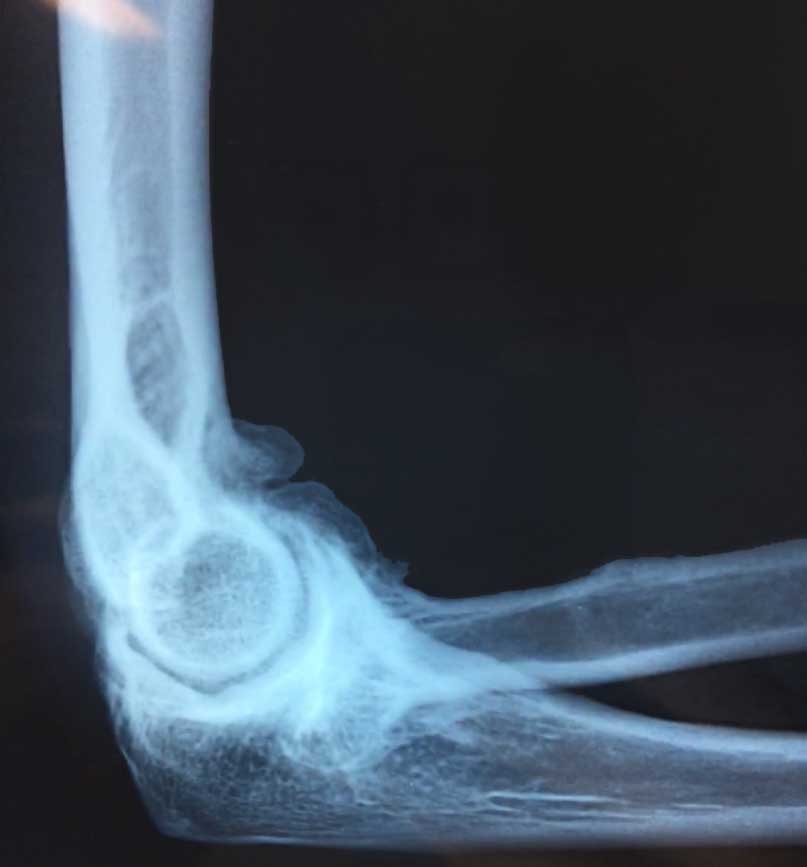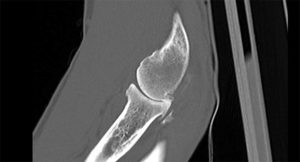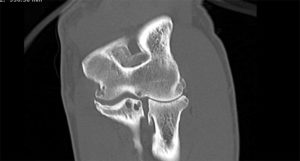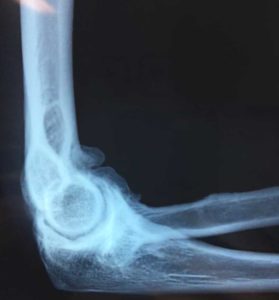Primary osteoarthritis (wear and tear of the joint) of the elbow is seen almost exclusively in males. Men with a history of heavy use of the arm, weightlifters and throwing athletes present in their thirties or later with sharp pains at the extremes of motion, typically with the arm straight more than when bent. Carrying anything, such as a briefcase, with the elbow straight is painful. Pain in the middle movements is present only late in the disease process. Inability to straighten the elbow the last 30 degrees is typical and may be associated with some loss of bending as well. The typical finding is pain on forced straightening or bending. As the disease process worsens the elbow becomes more stiff and bending becomes more difficult. At some point most men find it difficult to reach their face and shave and then present for treatment.

X-rays show extra bone “growing” around the joint and filling the spaces which allow the joint to move. There are usually loose bodies, which may not be “loose” because they are often stuck in the joint lining tissue.
A CT scan is useful to show the extent of the bone overgrowth and joint damage. MRI scanning is a less useful test because it does not show the bone overgrowth well.
Avoiding Surgery
The treatment for this condition starts with activity modification. Osteoarthritis is often linked to repetitive overuse of the joint, so modifying work or sports activities can be helpful. Intermittent periods of rest can relieve stress and pain in the elbow.
- Panadol or non-steroidal anti-inflammatory drugs may give temporary relief from the pain.
- Heat or cold applications and gentle exercises may be useful.
- Splinting of the elbow (allowing movement during the day or keeping it still at night) may protect the elbow from stress but does not provide a long term solution.
- Devices such as handle extensions can be used to maintain daily activities but are generally not tolerated by active males (these do work well in conditions such as rheumatoid arthritis).
Surgery
Treatment of primary degenerative arthritis is possible in the early stages by removal of the extra bone by open or arthroscopic surgery. If the joint is badly damaged the surgery will not work as well and joint replacement surgery may need to be considered. If the joint is maintained but there is overgrowth of the bone the surgery is very effective.
Nowadays arthroscopy is the most common form of treatment.
The open procedures which are possible are the column procedure and the Outerbridge-Kashiwagi (OK) or ulnohumeral arthroplasty but the column procedure is now the open operation of choice for stiffness from bone overgrowth and capsule thickening.
Improvement in pain and function occurs in approximately 90% of patients.
Post-traumatic Arthritis
Post-traumatic arthritis is arthritis which follows some form of injury to the joint. It can occur following many different injuries but is most common with fractures that extend into the elbow joint. Stiffness is common and difficult to avoid since the first priority is to get the broken bones to heal.
Rheumatoid Arthritis
Rheumatoid arthritis is a disease of the soft tissues which results in painful loss of movement in the elbow. This is a profoundly disabling condition which can be dramatically helped by surgery. Patients often have one elbow replaced and then request surgery on the other side within just a few months.
After failure of appropriate medical treatment, surgical options considered include arthroscopic synovectomy and capsular releases, radial head excision and TEA (Total Elbow Arthroplasty/Replacement). In general, patients younger than 60 years are considered for synovectomy, while those older than 70 years are treated by TEA.


